Allergies and Artists: A plein air painter shares how the “exhausting and convoluted” journey to find art materials that don’t aggravate his allergies. Can his findings help you?
Acrylics and the Allergic Artist
BY BRETT WEAVER
It has been an exhausting and convoluted journey finding art materials that I am not allergic to.
First … I just want to say my intention is not to endorse or give a negative review on any of the products or companies mentioned in this blog post. This is merely meant for informative purposes to share my ongoing struggles with allergies and the trial and error of products I’ve experimented with to arrive at the materials I’m currently able to tolerate in my studio.
I’ve had horrible allergies all my life, but I’m not sure I ever really understood the extent of how bad they could be until I moved to Chattanooga and spent every day working as an artist. For starters, Chattanooga is arguably the worst possible place for allergy sufferers in the entire country, setting me up to fight a losing battle from the get-go. But still, who knew there were so many things that one could be allergic to in an artist’s studio? Not to mention the things that are toxic or may even cause cancer.
Fortunately for most people, this (allergies) is not a problem. However, it seems that more and more people are becoming aware of allergies and definitely more concerned with toxicity and their health. I’ve had so many people approach me in the last few years to ask me what materials I use and tell me about how headaches and health problems have forced them to stop oil painting altogether.
I think many people are just not aware that an allergy is what they are dealing with and just blame it on the toxic fumes. Try telling your doctor that you feel bad and you stay exhausted all the time, and you think it’s probably because you’re an artist and exposed to paint all day long. You usually get the typical eye-roll. Then they smile like you’re crazy and proceed to tell you that unless you have poor ventilation and stay in your studio constantly, there shouldn’t be any issue. This basically describes almost every serious artist that I know.
Although many people view painting as a relaxing hobby that retired people do just for fun, artists work very hard and painting can definitely be exhausting, but not to the point that it takes you a full day or two to recover every time you paint. That’s the way I felt for the first year or two that I painted full-time. Some days I felt like I could barely walk or talk when I left the studio at night, and sometimes I never even left the studio because I lived there. At times, I’ve even slept in my car because I had to get away from the fumes. Fortunately, I haven’t had to live in my studio for years, but I think many artists have to do that, or whatever it takes to “make it” at some point in their career.
From most of the research I’ve done, oil paint is typically not toxic unless it contains lead, cadmium, cobalt, mercury, etc., and those may not be of major concern if you wear gloves and don’t eat or sand the paint. As much as I love cadmium lemon and cobalt, there are plenty of options for artists to allow them to avoid the toxic chemicals that are in some paints. It’s definitely possible, but I’m assuming most artists who are having headaches and congestion from the “paint fumes” should not be so quick to blame it on the paint. The solvents, thinners, and mediums we use to dilute or paint and clean our brushes … these are the usual suspects that become volatile. Go to any random artist studio and you’ll find the lid off their turp can all day long, and they rarely stop to crack a window.
Or what about the plein air painter? Sure, you’re outside all day, but most artists keep their turp can right in front of them with the lid off. So, it’s basically going right up their nose. The big question is whether the problem is caused by an allergy or toxic exposure. I’m not a doctor or scientist … so I make no claims either way, but I’m smart enough to figure out that if something is giving me a headache, it’s probably a good idea for me to get rid of it or reduce my exposure to it. For me, the first obvious problem I was aware of was basically everything labeled as a petroleum distillate, which may include mineral spirits, paint thinners, varnishes, polyurethanes, some resins, etc., even the added impurities in many products that may not be listed.
Then there’s the possibility of being allergic to the binder in the paint. Most of these are derived from plants or natural products, which certainly makes it possible to be allergic to any of them. Okay, so what are the obvious ones? Linseed oil, safflower oil, walnut oil, poppy seed oil, maybe even spike lavender.
Or you could even be allergic to the painting surface. Cotton? I’m guessing that’s rare … hopefully not or you would need to get rid of all your clothes, BUT linen is very much a possibility. Flax allergies are becoming more common. For me, it’s sort of like being allergic to ragweed and then deciding to roll around in a field of it all day every day and then wondering why I feel bad … hmm? Flax is all over my studio. It’s probably my favorite material to paint on, too, making it very difficult to find a suitable alternative.
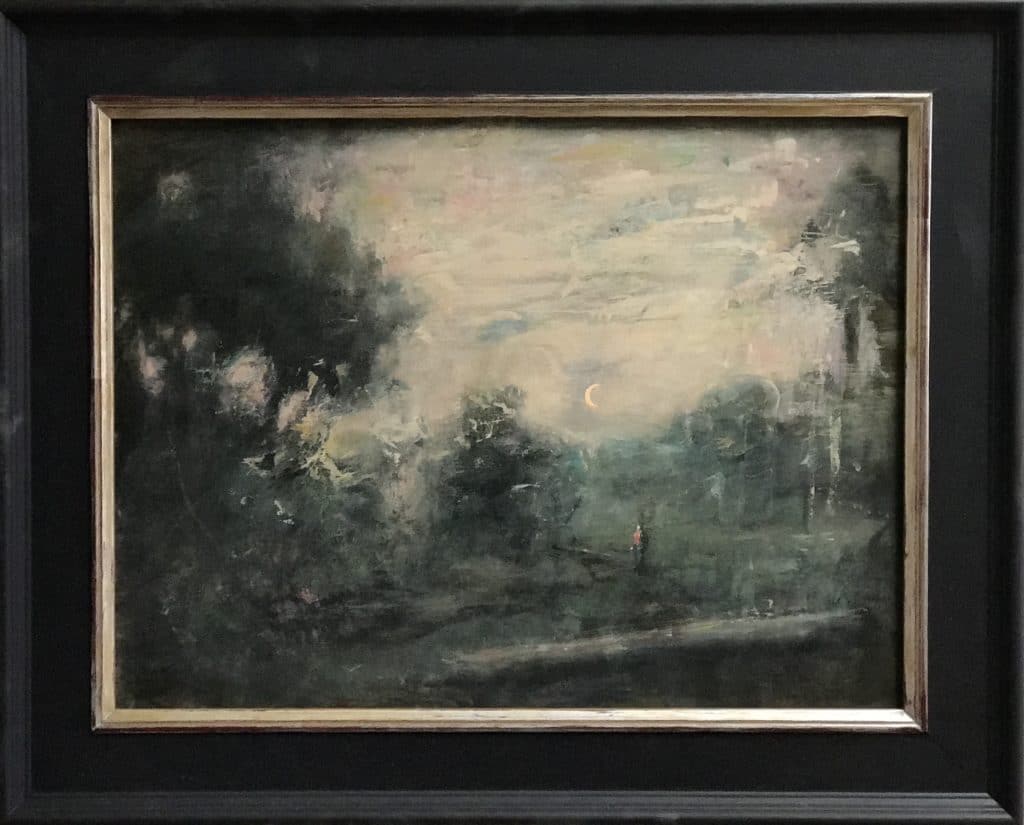
After you do finally become aware you are allergic to something, identifying what’s causing the problem is the difficult part. You can get rid of everything, one item at a time, until you feel better, or you could try getting rid of everything except what you think you’re allergic to and then see if you still feel bad. I guess you could even take the food allergy approach and remove everything and then slowly introduce everything back in, one item at a time, until you feel bad again, and that’s the source of all your problems. Unfortunately, most of us don’t have that much willpower. We just suffer through it, or we give up and quit, which is quite often the same thing.
Here’s a little bit of history about myself. About 19 years ago I quit my engineering career with an unstoppable determination to pursue a career as a full-time artist. That first year was rough, not only because I really had no clue about how to make a living as an artist, but also because I found myself having to spend a day or two recovering for every good and productive day I had painting. This was the first time I had ever had the time to paint every day. Previously I had typically blamed my fatigue and lack of focus at work on the fact that I was working my regular job all day and then going home and painting until 1 a.m. two or three nights a week. I guess I assumed it was the mere lack of sleep. I had also considered the possibility that it was from the toxicity of the paint, but it had never occurred to me until this point that I might be allergic to the paint and solvents in my studio.
My studio was in an old rundown building, which I lived in for the most part, because the rent was so cheap. I think I paid around $150 a month for 1,400 square feet. I’m certain that didn’t help any either. I slowly started to identify all the things that were making me feel bad when I used them: paint thinner, turpentine, damar retouch varnish, most mediums and solvents, and even linen canvas, especially when I would open a new roll. If I got rid of all of this, there would be nothing left to paint with. I talked to a few professional artists and they said, “Oh, everybody feels crappy after painting hard and being exposed to the paint all day long.” But it became obvious to me that this was a bit extreme in my case.
I was already taking weekly allergy shots for environmental/outdoor allergies. However, like I said, my first thought was that it was the toxicity of the paint thinner. I think I first switched from cheap hardware store “odorless” mineral spirits to Gamsol, which honestly helped a lot, but the headaches soon got worse again. Next, I tried one of the citrus thinners, but it smelled so strong that I could hardly stand to go in the studio. Then I went to an Eco-House product called Neutral Thin, which also helped a lot, but the headaches just didn’t go away.
Finally, I got rid of all solvents and for years I used no solvents or paint thinners. I just used a different brush for each value of the painting and made sure I tossed the brush aside when the color became too dead and muddy. You really have to get creative when there are no materials that you can use. It makes for great color harmony, but you can tend to have a lot of gray paintings if you’re not careful.
I started using walnut oil and soap or baby oil to clean my brushes at the end of the day. This worked well, and I actually ended up using this method for quite a few years. Somewhere around that time, a representative from M Graham must have gotten wind that I was going for a solvent-free approach because I received a box of Graham walnut oil-based paints in the mail, which I was very grateful for. I think this was the first time I had ever realized there were paints available that didn’t use linseed oil as the binder.
That’s when another light bulb started to go on: “Maybe it’s the binder!” Even then, there was a possibility that I was allergic to walnut oil because I had removed all solvents, but even though the headaches were gone, I was still going home congested and in a daze every night. I was also still using linseed oil-based paints. So if one of them was causing the problems, I couldn’t afford to just throw away half of my paint to see if it helped. And you know how it is, there are certain colors by specific brands that you think you just can’t live without.
I continued to suspect that linen could be another possibility because I would feel really bad every time I would roll out a new roll of linen to stretch canvases. After doing a little research I realized that linen and linseed oil both came from the same plant: FLAX! I had no idea! This could not be a coincidence. I remembered that I had even tried the water-soluble oil paints for a while, and they actually affected me even worse than ordinary paints. Then it occurred to me that even though they were water-soluble they still used a derivative of linseed oil for their binder.
Since I was already taking allergy shots anyway, I decided to do some research on the flax plant. It certainly did not grow in Tennessee, meaning that it probably would not have been included in my previous allergy test. You know, it’s basically flaxseed oil, the stuff that people were starting to consume large quantities of in their morning smoothies to make themselves healthier. How could you be allergic to that?
The next time I went for allergy shots I asked the nurse about it and she looked at me like I was an idiot and proceeded to explain how this sounded very crazy and highly unlikely. Just to humor me and take my money, I suppose, she said she would special order the allergy test. I came back the next week for the test and it turned out I was extremely allergic…
Flax was added to my weekly two-shot concoction, which meant they would slowly shoot a little more flax into me each week to try to build up my immunity to it. About a month later I attended a wet paint plein air event where there were probably about a hundred fresh wet paintings in the room. About halfway through the evening my body suddenly started shaking and itching and I had to go outside for air. The next week I told the nurse and she immediately ordered me an Epi-pen for flax, which I carried around to every plein air event for years.
For a long time, I just dealt with the problem, with a daily regimen that included Benadryl and a trip to the steam room at the gym just so I could breathe again. A few years ago, before the birth of our children, I decided to get more serious about it and began only using walnut oil-based paints, entirely removing all linseed oil-based paints and mediums from my palette. Amazingly, at that point, the daily trips to the sauna ended, except for about once a month when I stretch canvases.
Although the no-solvent-or-thinner approach has proven successful, I was really missing the ability to have a thin wash or underpainting to start my paintings, as well as an easy way to clean my brushes. I started doing some research again and stumbled on a company called Art Treehouse, which brands itself as “A Less Toxic Art Place.” They sell a product called Biobased Artist Thinner, made from soy beans, which contains no mineral spirits or turpentine and claims to be non-hazardous, very low odor, and low VOC. It’s an amazing product and thinner substitute for anyone with an allergy to petroleum distillates or if you just want a healthier studio environment! It’s the first thinner I’ve ever been able to use that actually does what I need it to do and doesn’t give me a headache. I occasionally use it for thin washes or underpainting, but it works best for cleaning my brushes. I actually try to use it sparingly for painting because it’s such a good brush cleaner and paint remover that I can sometimes wait two or three days to clean my brushes and it will still take the paint off. They also make walnut oil-based paints, giving me another alternative for paint.
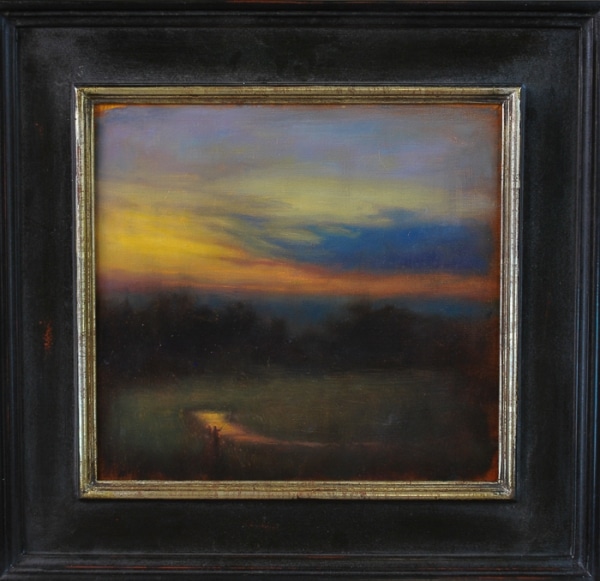
“Final Cast” was my first painting done using the Biobased Artist Thinner. Currently, for oil painting, I only use MGraham or Art Treehouse paints and Biobased Artist Thinner.
Art Treehouse also led me to several other products to substitute in mediums. I discovered their water-washed walnut oil. It’s a cleaner and faster-drying walnut oil that I often use alone as a medium. For a long time, I’ve been looking at other alternatives to use in the more popular homemade mediums, which typically contain damar, linseed oil, and turpentine. I tried the relatively expensive spike lavender as a substitute for turpentine … allergic to that too! Next, I tried rosemary oil, which is not cheap either, but it’s actually very helpful for allergies and worked very well. I found Canadian balsam as a substitute for damar, and I use water-washed walnut oil instead of linseed or stand oil. It’s a little more expensive and doesn’t dry as fast as the turpentine-based mediums, but it has proved to be a sufficient medium I can tolerate and actually enjoy smelling in the studio.
Now all of my problems are solved, right? Not quite. I still haven’t found a sufficient substitute for linen. Fortunately, I get the worst reaction when I unroll a new roll and stretch or mount my canvas. I used to just spend an entire day prepping as many canvases as I could manage to get finished and then let them air out for a few days. I’ve had some good results with gessoed panels recently, too, although I don’t like it as much as linen. I use gessoed birch, aluminum, and gessobord panels, as well as Blick premium heavyweight canvas. Currently, I’m trying not to use any linen at all if I can help it, and it seems to be working out.
I still haven’t found the perfect solution. Other issues that have been hard to deal with are attending shows and plein air events, which I’ve stopped doing, and I can rarely go into other artists’ studios for more than just a few minutes. But the hardest thing to deal with has been teaching. Students typically just bring whatever they already have, or they just shy away because they don’t want to purchase a whole new set of materials. So, by the second day, I’m already in a daze.
I recently recalled a couple of friends who are really good artists telling me about using these “amazing new acrylics that acted so much like oils you can hardly even tell the difference.” That was four or five years ago … At the time I came home and immediately purchased a complete set of Golden Open Acrylics that have just been on the back of one of my shelves for years. After digging around in my studio, I found the bag of acrylics and decided to give them a shot.
I guess I had never used them because I was afraid of wasting time trying to learn something new, as well as the whole stigma of acrylics not being of the same quality as oils. Using the correct and highest quality materials you can afford is very important, but I have to believe that it’s not so much about the materials you use as it is about what you have to say and express with the materials you have. I think many of the Old Masters would have been willing to try them, otherwise, nothing in painting would have ever changed or evolved in the past 400 years.
I’ll admit I was a little nervous about how to mix acrylics and not have them dry out before I ever had a chance to get the paint on the canvas. I was pleasantly surprised and amazed that I could keep the paints wet for hours and blend edges, and they didn’t seem to dry a shade darker the way regular acrylics tend to do. Even though they dry slower, I still found myself being able to layer the paint much faster than with oil paints. I actually had more fun painting with these paints than I have with oils in quite some time, just because I was able to experiment with different effects of dragging, scratching, and scraping paint and didn’t have to wait forever for my underpainting and layers to dry when working with tonalism techniques.
There are a few drawbacks to using the Open Acrylics. They have to dry for quite a while before you can varnish them and you can’t paint very thick or maintain brushstroke texture like you can with oil paint. Although I do love impasto painting, the pros definitely outweigh the cons. So, for me, that’s not a deal breaker. The best thing is that I don’t seem to be allergic to them!
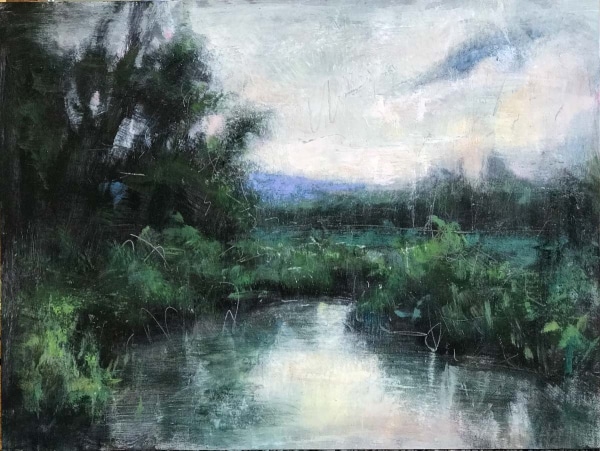
“Minor Tributary” is my first attempt at using Open Acrylics. I think I was totally sold at that point. Below are a few of the other recent paintings done in acrylics.
Although I do continue to work in oils and honestly still prefer oils over acrylics, I’m pretty much sold on the Open Acrylics. I can use water to clean my brushes and I typically paint on gessoed panels. I also don’t have to deal with solvents when I’m on a painting trip. This basically solves all of my allergy issues, and you can hardly tell the difference.
Below are several more examples of my acrylic work.
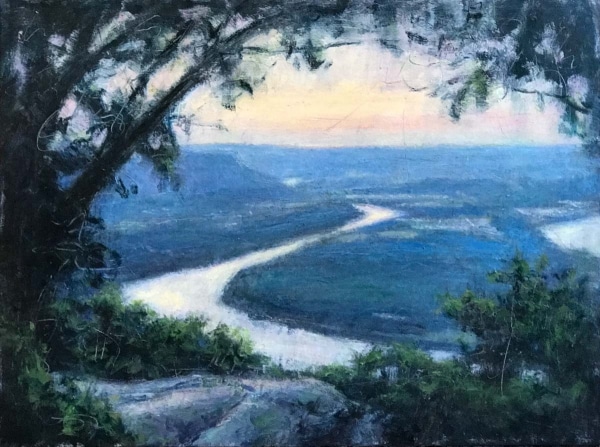
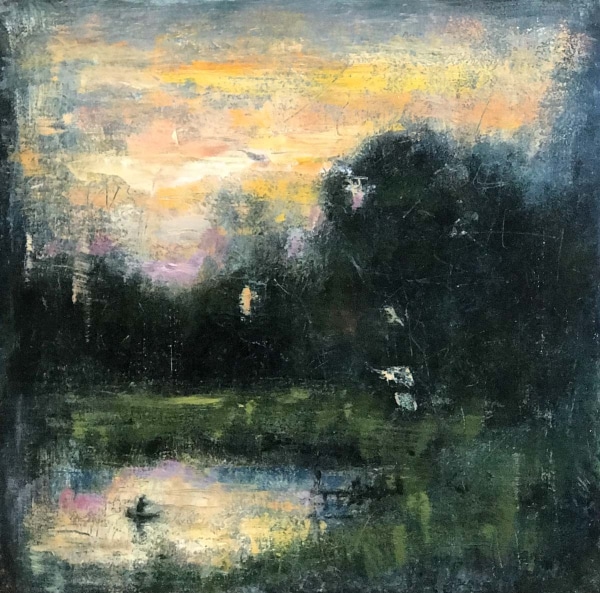
Connect with the artist at brettweaverstudio.com.
And browse more free articles here at OutdoorPainter.com

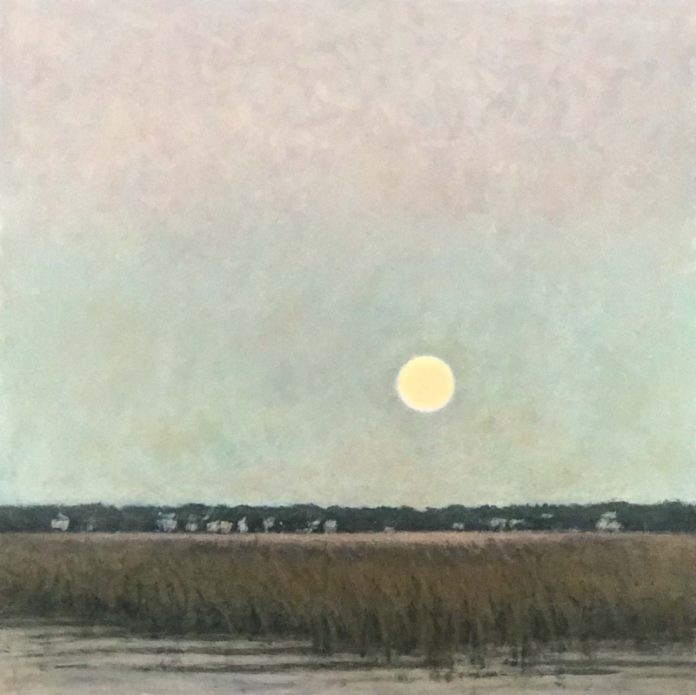



This is the story of my life!!! Different allergies possessed my whole life for the last 15-20 years and forced my retirement. Then I started painting. Same story but I knew enough not to try oils. Watercolor was not my thing either. I’ve ended up with Golden Open products and I love them Even better than regular heavy body acrylics. I can use oil painting techniques and attend oil workshops that don’t include turpentine. Thank you so much for sharing OUR story.
Quite the story of finding a medium that works for you. Very persistent. I too use Golden Open Acrylics both in the studio and plein air. I had used oils for years en plein air but didn’t want to smell the solvents all day long in the studio. I am not allergic to anything but since my studio at that time was within the home living area I didn’t want to subject the family to the blended smell of paint and pot roast dinner. Not appetizing at all. So I switched my studio to acrylic and watercolor–both water soluble mediums that did not leave an overpowering smell of chemicals in the air. I also switched my plein air set to Golden Open Acrylics too. I experience the same effects of thin layers of color but I so love the fact that it is water cleanup. And I use the two Open mediums to be sure to keep enough binder in the paint. I also still use regular drying acrylics as underpaintings and use gloss medium to create a more slippery painting surface on canvas or panels of all sizes. I also mix some heavy gel medium into the Open to attain a more impasto surface but only on the topmost layer. I have recommended Open to many of my painting friends as a great alternative. Just takes some playing with it to adjust to its different working qualities. To each his/her own. Good luck to you with your work.
I too us acrylics (regular) and have never had anyone assume that they weren’t oil paintings. I like the drying time and use it to my advantage. It can be tough en plein air with dry air and wind, however, you just have to be willing to scape off the palette if it becomes gummy.
You are my new best friend, I thought I should tell you that straight off. I feel crazy telling people that I can’t use oil, I have to use it, I just got good at it again. The 🙄 eye rolling, the just use… is infuriating. I have tried every which way to use oils, it has to be the binder! I will try Graham again with just the walnut oil and palette knifes.
I haven’t even tried allergy tests; you have done so much work for me,
that’s why I said the best friend comment, thank you.
I have eliminated everything, except just using walnut oil. PleinAir with a respirator- and a fan and only water right now. I hold my breath and step back rapidly but I am still sitting here with my chest aching hours after I had to stop. After these commissions, I am ready to try Open Acrylics. Thank you for this article, I am hopeful again. I tore apart my website which is just my name, it should be up in a month. Best of luck, Lisa
Btw your work is lovely!
I’m reading your article because after a day of painting outside exterior acrylic latex, I cannot breathe through my nose at all, Some sneezing. And my eye burn terribly. Of course, my body hurts but that might be my age. So far , I’m not allergic to anything; however I’m sure there something in this paint that I’m allergic
Oh my God, thanks so much for this article. I had been mostly painting in acrylics but started experimenting in oils recently — it took me several starts and stops to really figure out that it was the oil paints making me so sick. After my last 2-day oil workshop, it took me almost an entire week to recover. Just like you, Brett, the headaches won’t go away, the fatigue is devastating, and the mind haze is crazy. I now think I know why so many of the old masters lost their minds.
I’m stopping oils and solvents entirely and going back to acrylics, but I’m really going to miss the oils. So thanks for mentioning the Golden Open Acrylics, I’ll check them out.
And thanks so much for sharing your story and your symptoms, it helps a lot.
A very enlightening story, Brett! I too appreciate you sharing your personal journey through allergies as it helps answer many questions and suspicions I’ve had over the years.
[…] Acrylics and the Allergic Artist […]